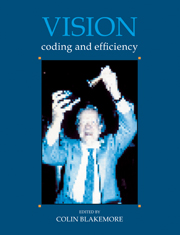Book contents
- Frontmatter
- Contents
- List of Contributors
- Preface
- Reply
- Acknowledgements
- Concepts of coding and efficiency
- Efficiency of the visual pathway
- Colour
- Brightness, adaptation and contrast
- 15 The role of photoreceptors in light-adaptation and dark-adaptation of the visual system
- 16 Why do we see better in bright light?
- 17 Mechanisms for coding luminance patterns: are they really linear?
- 18 Feature detection in biological and artificial visual systems
- Development of vision
- Depth and texture
- Motion
- From image to object
- Index
16 - Why do we see better in bright light?
Published online by Cambridge University Press: 05 May 2010
- Frontmatter
- Contents
- List of Contributors
- Preface
- Reply
- Acknowledgements
- Concepts of coding and efficiency
- Efficiency of the visual pathway
- Colour
- Brightness, adaptation and contrast
- 15 The role of photoreceptors in light-adaptation and dark-adaptation of the visual system
- 16 Why do we see better in bright light?
- 17 Mechanisms for coding luminance patterns: are they really linear?
- 18 Feature detection in biological and artificial visual systems
- Development of vision
- Depth and texture
- Motion
- From image to object
- Index
Summary
We have recently been doing some experiments inspired by Horace Barlow's ideas about adaptation and spatial integration. But instead of looking for support for Horace's point of view, we have been hoping to displace one of his ideas by one of our own. This revisionist attitude can be justified by an argument from information theory. Barlow is almost always right, so further demonstrations of his correctness are largely redundant; to catch him out is more difficult but also in a quite objective and technical sense more informative.
It is obvious that at high levels we see textures and details that we miss when the illumination is dim: more light means better sight. This improvement could be due to any of a number of factors, but here we wish to examine one suggestion in particular: that the improvement in vision occurs because light adaptation changes the spatial organization of the retina. That some such change occurs is well documented physiologically. Neurons in the vertebrate visual system typically receive antagonistic influences from the centre and surrounding regions of their receptive fields (Barlow, 1953). Barlow, Fitzhugh & Kuffler (1957) found in cat retinal ganglion cells that light adaptation increases the prominence of the antagonistic surround relative to the centre, thereby reducing the effective size of the central summing area (or, roughly speaking, of the spatial integration region) of each cell. As Barlow (1972) has noted, the effect is rather like reducing the grain size in a photographic film. Like the photographic analog, it could provide an efficient way of regulating sensitivity, because the system would gain a useful improvement in resolution by sacrificing sensitivity that is no longer needed or even desirable.
- Type
- Chapter
- Information
- VisionCoding and Efficiency, pp. 169 - 174Publisher: Cambridge University PressPrint publication year: 1991



